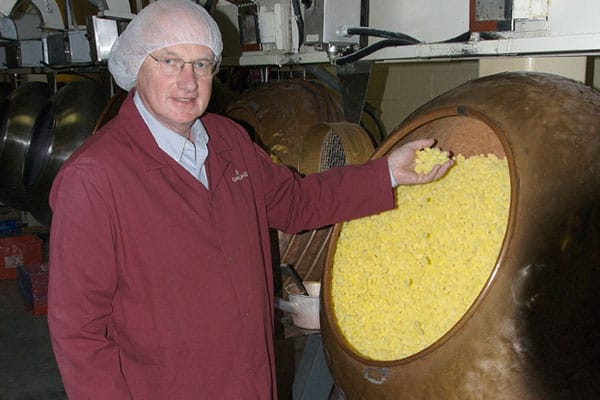He's been called Canada's Willy Wonka, and David Ganong-president of the country's oldest candy manufacturer for the past 30 years-shares with his fictional counterpart a passion for sweets. From his office at Ganong Brothers Ltd., 1 Chocolate Drive, St. Stephen, NB, David talked to Saltscapes about growing up beside a candy factory, eating chicken bones and building empires in Atlantic Canada.

Q As a member of a candy dynasty were you popular at school?
A I can't ever remember taking candy to school to hand out. Maybe the Ganongs were stingy with the samples… Next to the hard candy room in the factory was an apple orchard. We would throw apples up to the candy makers, who dipped them in candy and threw them down to us after they cooled. I got into a lot of trouble with my parents for doing that.
Q What do you give out for Halloween?
A A combination of Pal-o-Mine bars and fruit snacks. My grandfather, the inventor of the chocolate bar, gave out apples.
Q How many kids do you get at your door?
A It's been in decline; in the area of 75. There were times that it was well over 100. I don't think we're necessarily targeted.
Q You're known for your sweet tooth. How much candy do you eat?
A Not as much as my predecessors. [My uncle] Whidden believed he ate a pound of chocolate or candy a day, and his father before him more than that. A terrific amount of quality control occurred on the plant floor in those days. You'd have candy makers come up and say, try this and try this.
Q Ganong invented chicken bones in 1885 and released the first heart-shaped chocolate box in 1932. What's your favourite innovation?
A It's the chicken bone. We still make a chicken bone that's different than anybody else's, and we still make it by hand.
Q Why is it so popular in Atlantic Canada?
A The unique combination of cinnamon and chocolate combined with the bite. You've got the sweet cinnamon flavoured jacket and the bittersweet chocolate in the centre. The way you eat a chicken bone is to bite through it, breaking the jacket.
Q In its 134-year history, the company must have faced obstacles and challenges. What was the most significant?
A From the history book there were a number: sugar rationing and lack of labour during the war. We did have a sugar run-up during the 70s, a very serious moment where the company required financing and family members were not getting along.
Q Have your children worked for the company?
A All three of them, as I did, worked on the plant floor during summer vacations, working in the pan room, lugging sugar bags, you name it, which was a good experience for them. Two are currently working with us: Bryana on the executive team; Nicholas is working as a supervisor in our chocolate enrobing room.
Q Do you hope one of them becomes the company's president some day?
A That would be nice. It depends on their capabilities and their interest, desire and drive… There should be a connection between leadership and ownership.
Q What do you think is required for business to succeed in Atlantic Canada?
A The long-term sustaining industries are those that have their roots here, have their ownership here and have their head offices here. As industries go through turmoil, the place you live, the head office, is likely to be the last to fall…. The number one thing we should be working towards is creating an environment that will encourage young people to try their ideas here, to find the next K.C. Irving or Harrison and Wallace McCain or Frank Sobey - to build some empires for tomorrow.
